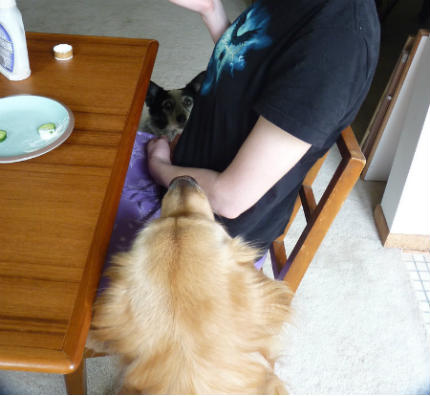In addition to affection and companionship, humans can share other things with their pets, including some illnesses. Well yes, there are different diseases that, although it may seem incredible, can affect the health of both humans and that of a dog or cat.
Although the manifestations of some of these pathologies may be different in dogs than in humans, the condition is the same, and its presence could put the lives of pets at risk.

What are these diseases that dogs and humans can share ? How to identify them in our pet?
Below, in this article we develop some of the most common pathologies that humans can share with their pets. And we will also present some symptoms that will allow them to be identified in time.
Diabetes
This is one of the most common pathologies between humans and their pets. Specifically, in animals such as dogs and cats, the appearance of Type 1 or 2 Diabetes is becoming increasingly common.
In humans, the appearance of this disease is caused by a sedentary lifestyle, poor diet or genetic reasons. In the case of animals, the causes do not usually vary, and diabetes is linked to the same risk factors.
Inadequate feeding of pets, lack of exercise or walks and even hereditary causes can cause the appearance of Type 1 Diabetes in our dog, which is the most common in these animals.

How to identify Diabetes in a dog?
The symptoms of this disease in our pets are very precise. Noticeable weight loss is the first evidence that something is wrong.
If, in addition, this is accompanied by an excessive need to drink water and urinate frequently, it is very likely that the pet is being affected by some type of diabetes.
Going to the veterinarian immediately if you observe any of these irregularities is the most reasonable thing to do to determine whether or not it is this pathology.
Thyroid problems
Although it can occur with different frequency in each animal. The presence of hyperthyroidism in cats and hypothyroidism in dogs is quite common.
The causes of this disease in animals have not been clearly determined, however, it is usually closely associated with hereditary reasons, to a large extent.

How to identify a Thyroid problem?
When it comes to very active animals that are affected by this disease, it is identified with a clear decrease in energy on the part of the animal. Our dog is seen tired, slow and with a tendency to constantly gain weight. If these symptoms are observed, they may indicate that the dog is suffering from a Thyroid problem and it is recommended that it be examined by a veterinarian to determine if this is the case.
Epilepsy
Episodes in which frequent seizures occur, both in humans and animals, are signs that identify Epilepsy. This disease affects both humans and their pets considerably.
A neurological condition, or genetic reasons, are the most common reasons why this disease manifests itself.

How to recognize epilepsy?
Detecting epilepsy in animals is usually not so simple. The disease is usually discovered by the presence of a seizure.
Some veterinarians recommend dog food rich in fatty acids for their reduction and even prevention. In other cases, this condition is treated with drugs, although they are not always effective.
In any case, it will be the veterinarian who will be in charge of indicating the best way to treat this pathology.
Pulmonary hypertension
Another common disease that humans and pets share is pulmonary hypertension . Very common, especially in dogs.
The causes of this pathology can be diverse, so determining a specific one is a bit complicated.
Although it may seem unusual, the treatment provided to pets with this condition is Viagra . Although it is used in humans for very different purposes, in dogs it is used to reduce high pressure in the lungs.

How to identify it?
The dog's collapse or shortness of breath is the most direct way to discover this disease. If you notice the presence of any of these symptoms, it is ideal to consult your veterinarian as soon as possible.
heart problems
Heart disease is another very common disease in both humans and pets.
Arrhythmia and even heart attacks can affect the central muscle of our animals, as well as our own.
Inadequate diet, a sedentary lifestyle and hereditary causes are the main factors that intervene in the health of humans and pets to keep their hearts healthy.
Dogs that tend to have nervous behavior are more prone to suffering from this disease.

How to identify it?
Nervousness and weakness are some of the ways to identify this condition. However, it is very common for a heart attack to come unexpectedly. Maintaining veterinary control is a way to prevent this pathology.
Obesity
This is a very common condition in both people and animals. In both cases, the cause of the disease may be associated with inadequate or uncontrolled diet. This pathology is more inclined towards the lifestyle and nutrition that the individual has, and the same happens with animals.

How to identify obesity?
The way to identify obesity is very simple. A progressive weight gain that causes difficulty moving, discouragement or apathy on the part of the dog when performing physical activities is the most obvious.
Maintaining a balanced nutrition, combined with exercises or long walks, will help the pet avoid this pathology. You can also read our tips to help our dog lose weight.
To sum up
All of the aforementioned diseases can occur in both humans and pets, commonly in dogs and cats. And in both, the causes may be similar.
Although some of the pathologies presented are genetic, most can occur due to inadequate or uncontrolled diet, sedentary lifestyle and other causes that can be prevented.
Keeping your pet well fed, exercising daily and maintaining proper control with the veterinarian will be enough for your companion to lead an adequate lifestyle and stay healthy.
Other curiosities that may interest you:












